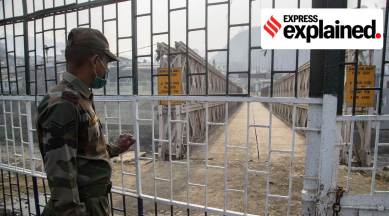Explained: Mizoram’s bond with people fleeing Myanmar
Centre wants these Myanmar nationals deported, but Mizoram wants political asylum for their ‘Mizo brethren’. A look at their common roots and continuing bond.

Mizoram Chief Minister Zoramthanga recently held a virtual meeting with Myanmar Foreign Minister-in-exile Zin Mar Aung of the National League for Democracy. The meeting took place despite the Centre’s unwillingness to accommodate people fleeing Myanmar in light of the military coup and the crackdown on protesters — the Home Ministry had written to the governments of border states Mizoram, Nagaland, Manipur and Arunachal Pradesh, as well as the Assam Rifles, asking them to identify and deport Myanmar nationals fleeing the coup.
Mizoram has been reluctant to send back Myanmarese and sought that they be provided political asylum by the Centre. In a letter to Prime Minister Narendra Modi, Zoramthanga wrote: “It may be mentioned that the Myanmar areas bordering Mizoram are inhabited by Chin communities who are ethnically our Mizo brethren with whom we have been having close contact throughout all these years even before India became independent. Therefore, Mizoram cannot just remain indifferent to their sufferings today.”
monthly limit of free stories.
with an Express account.
Who are the Chin communities mentioned by the Mizoram CM?
The Indo-Chin hill ranges are a mountainous region in north-western Myanmar. It was the home of numerous tribes that fall under the Zo umbrella — such as Chin, Kuki, Mizo, Zomi, Paitei, Hmar, Lushei, Ralte, Pawi, Lai, Mara, Gangte, Thadou etc.
Believed to have originated in China, the tribes migrated through Tibet to settle in Myanmar, and speak a group of the Tibeto-Burman languages. But constant feuds among clans of different tribes and their kings (chieftains), drove many of the clans westwards, towards Mizoram and some parts of Manipur, in the 17th century. Here the tribes set up new villages and colonies, but even with their new identities, they remain socially and emotionally tied with the Chin tribes of Myanmar.
When British rule extended towards the Northeast, Mizoram was denoted an “excluded area” and remained outside the administration of the British, governed only by the Scheduled District Act. While they are separated by a 510-km India-Myanmar border, they consider themselves “one people’’ despite past conflicts: the Indo-Chin people.
Besides the shared ethnicity, what binds these two peoples together is a shared religion. Mizoram is predominantly Christian, as are the Chin people of Buddhist-majority Myanmar. Mizoram officials refer to the refugees’ status as a Christian minority people in seeking asylum for them, and also the fear of persecution by the junta.
How well are the two sides connected?
The Mizoram-Myanmar border is porous, with very little fencing, if any. While the latest influx has been driven by the coup, Myanmar residents have been crossing this open border for decades.
Also, many Mizo families had migrated to Myanmar in 1966 and 1986, when the Mizo National Front sought secession from India, to escape counter-insurgency operations from the Indian government.
In 1988, a crackdown on pro-democracy demonstrators in Myanmar drove Chin refugees across the Tiau River to Champhai district in India and have since been integrated into Mizo society.
The Mizo social fabric spans across the border, which now separates families. While the two countries have an arrangement called Free Movement Regime (FMR) that allows locals on either side to go up to 16 km on the other side and stay up to 14 days, thousands regularly cross over on either side for work and to meet relatives, often unofficially and for extended periods.
Marriages are often arranged across the border.
In border trade, Mizoram depends to a large extent on Myanmar for many essential commodities including beef, pork, good quality rice, fruits, and household utensils. Mizoram sends across items scarce in Myanmar such as medicines or fertilisers.
A road is under construction to connect the two countries through Champhai, and recent discussions have taken place between the Centre and the state to set up a Land Customs Station at Zokhawthar, also the site of an emerging township.
What is India’s policy on asylum seekers?
In 2011, the Centre circulated to all states and Union Territories a Standard Operating Procedure to deal with foreign nationals who claimed to be refugees.
An illegal immigrant can be a foreign national who enters India on valid travel documents and stays beyond their validity, or a foreign national who enters without valid travel documents.
Cases that can be prima facie justified on grounds of well-founded fears of persecution on account of race, religion, sex, nationality, ethnic identity, membership of a particular social group or political opinion, can be recommended by states or Union Territories to the Home Ministry for a long-term visa (LTV) after due security verification. LTV-holders are allowed to take up private-sector employment and enrol in any academic institution.
In the view of the Indian government, illegal migrants “infringe on the rights of Indian citizens” and are “more vulnerable for getting recruited by terrorist organisations”. Section 3(2)(c) of the Foreigners Act, 1946 gives the Centre the right to deport a foreign national. The power to identify and deport foreign nationals who are in India illegally has been delegated to the states, Union Territories and the Home Ministry’s Bureau of Immigration.
Illegal immigrants intercepted at the border can be sent back then and there.
What is happening in Mizoram right now, and what is the way forward?
Several Mizo village council authorities have issued letters and statements affirming their willingness to accommodate Chin refugees. Music concerts were recently held across Aizawl to raise funds for the Myanmar nationals in Mizoram.
Amid increasing pressure on the state government, it is unlikely that Mizoram will back down any time soon — unless the Centre devises a way out.